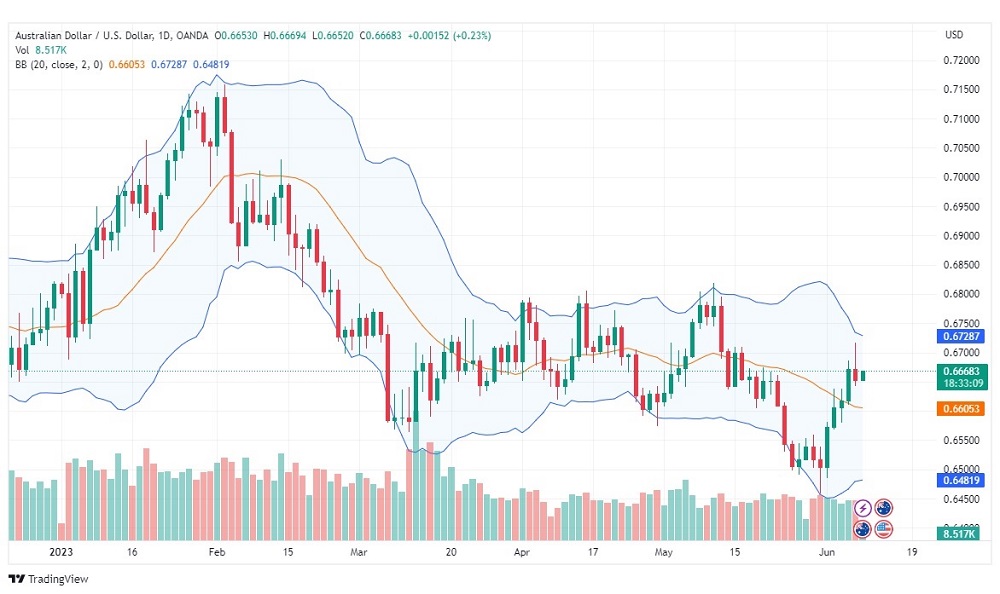For successful trading, traders must understand AUD/USD characteristics, trading analysis, pair correlation, volatility, and carry trading.

Trading AUD/USD is highly popular due to Australia's significant economic size and its prominent role in international trade, particularly in the commodities market. According to the 2019 Bank for International Settlements (BIS) report, AUD/USD accounted for 6.8 percent of total forex market transactions.
Examining the forex market history in April 2013, the US Dollar was involved in 87 percent of all trades as the world's primary reserve currency. On the other hand, the Australian Dollar, commonly referred to as "The Aussie," ranked as the fifth most traded currency, representing 8.6 percent of total trades.
To analyze and trade AUD/USD as a beginner, you should consider key factors. Firstly, monitor economic indicators and news releases from Australia and the United States, such as interest rate decisions, employment data, and GDP figures, as they can significantly impact the currency pair.
Secondly, employ technical analysis tools like trend lines, support, resistance levels, and moving averages to identify potential entry and exit points. Additionally, monitor market sentiment and global events that might affect risk appetite, as AUD/USD is often influenced by risk-on or risk-off sentiments.
The AUD/USD pair offers attractive liquidity and spreads. Its correlation with other forex pairs can also yield profitable opportunities. Therefore, it is unsurprising that AUD/USD is a favorite among traders. If you are a beginner trader who wants to try your luck with AUD/USD trading, check out the following guide!
Contents
Characteristics of AUD/USD Pair Trading
Like the Canadian or New Zealand Dollar, the AUD is highly sensitive to commodity price movements due to Australia's significant role as a major producer. There are several advantages to trading AUD/USD, including:
High Liquidity
AUD/USD boasts high liquidity as one of the most heavily traded currency pairs worldwide. Liquidity is crucial for traders as it determines a pair's ability to be traded efficiently without significant price changes or slippage.
Tight Spreads
As a widely traded forex pair, AUD/USD can offer relatively tight spreads for retail traders. This can reduce overall trading costs, which is often an important consideration when selecting forex pairs.
Available 24 Hours
AUD/USD can be traded 24 hours a day, from Monday to Friday, providing a seamless trading experience with convenient entry and exit conditions. It's important to note that the forex market is closed on Saturdays and Sundays, allowing traders to evaluate their trading results and devise stronger strategies during these off days.
AUD/USD Trading Analysis
As you may know, there are two types of forex trading analysis: fundamental analysis, which relies on economic news as the basis for analysis, and technical analysis, which focuses on price movements based on charts and technical indicators. Here is a guide to both fundamental and technical analysis for trading AUD/USD.
Fundamental Analysis of AUD/USD
The Australian Dollar is a major currency associated with risk. This means that it is highly sensitive to overall market sentiment. When the market conditions are favorable, AUD/USD tends to rise, while AUD/USD tends to decline during market pressures.
The price of gold exports, a major commodity in Australia, greatly influences the exchange rate of AUD/USD. Additionally, other commodity prices such as iron ore, coal, and copper should also be considered.
The price of AUD/USD reflects the fundamental strength of the Australian currency against the US Dollar. Therefore, there is a close relationship with Australian economic data such as
- Employment
- GDP growth
- Consumer confidence
- Inflation, and more.
You must stay updated on all fundamental economic news releases. During periods of economic boom, strong domestic growth and external demand tend to support the Australian Dollar. However, during downturns, slower growth and external demand often result in a weaker AUD/USD.
Another important factor for AUD/USD is the influence of policies issued by the Reserve Bank of Australia (RBA). The Australian central bank sets short-term interest rates and guides monetary policy on the first Tuesday of each month.
Dovish statements (indicating potential interest rate cuts) can cause AUD/USD to decline, while hawkish statements (indicating potential interest rate hikes) can cause AUD/USD to rise.
During economic downturns such as the Covid-19 pandemic, the RBA cut interest rates to record lows of 0.25 percent, resulting in a sharp decline in AUD/USD.
AUD/USD can also react quickly to Chinese economic data as the economic relationship between the two countries is closely intertwined. China's GDP, manufacturing PMI, industrial production, and retail sales are key data points affecting trading AUD/USD. Watching the economic calendar is very important.
Technical Analysis of AUD/USD
In technical trading of AUD/USD, you must identify the market trend, whether it is an uptrend, downtrend, or sideways movement. Traders usually prefer to follow trends and avoid trading in tight market conditions. Indicators commonly used to identify trends are the Simple Moving Average (SMA) and Bollinger Bands.
The Simple Moving Average (SMA) line can be calculated by taking the average of closing prices over a certain trading period, such as 20 or 50 days. During an uptrend, the SMA line tends to slope upward and move higher, with the short-term SMA (e.g., 20 days) crossing above the long-term SMA (e.g., 50 days). The opposite applies to a downtrend. Here's a chart of AUD/USD using the SMA indicator.

In an uptrend, AUD/USD can be traded above the upper half of the Bollinger Bands indicator. However, if the price reverses and falls below the middle line of the Bollinger Bands, representing the moving average, it could be a sign of a bearish trend reversal and vice versa. Here's an example of a Bollinger bands indicator on the AUD/USD chart.

The AUD/USD pair is volatile, meaning that breakout strategies are more effective during trending markets. The breakout strategy is a forex trading strategy that relies on price breaking through key levels (support and resistance) to trigger entry. This strategy can be a great opportunity to capture profits.
AUD/USD Pair Correlation
Forex pair correlation means the relationship between two pairs of currencies that influence each other in terms of price movements. There are two types of correlations, positive and negative.
The following table shows some of the currency pairs with the strongest positive and negative correlations to AUD/USD. The statistics are derived from daily market data covering 300 periods, starting from January 8, 2015.
| Positive Correlation to AUD/USD | Negative Correlation to AUD/USD | ||
| AUD/CAD | 0.94 | USD/CHF | -0.84 |
| GBP/USD | 0.92 | UDS/JPY | -0.88 |
| NZD/USD | 0.91 | USD/TRY | -0.94 |
| EUR/USD | 0.82 | USD/KAD | -0.94 |
| EUR/CHF | 0.66 | USD/SGD | -0.97 |
A positive correlation indicates price movements that tend to be in the same direction. The higher the correlation level, the more identical the moves. Meanwhile, a negative correlation indicates opposite price movements. The more negative the correlation number, the greater the difference in movement.
AUD/USD Volatility
Forex volatility indicates the risk involved in trading and the opportunities available. High volatility means higher risk, but also more trading opportunities. The AUD/USD pair is a favorite of traders looking for volatility due to the large interest rate differential between the two.
The greatest volatility in AUD/USD occurs on Tuesdays and Thursdays (around 80 pips), followed by Wednesdays. Intraday volatility usually spikes in the middle of the Asian session, specifically during:
- Around 00:00-01:00 GMT (20-25 pips), when economic data from Australia is announced.
- Between 12:00 and 15:00 GMT when US economic indicators are released (less than 20 pips).
A slightly smaller increase in intraday volatility is also noticeable during European opening hours at around 15-17 pips. Here's the volatility table for the AUD/USD pair, ranging from 1-minute to 1-month periods.
| M1 | M5 | M15 | M30 | H1 | H4 | Daily | Weekly | Monthly | |
| AUD/USD | 3.4 | 3.8 | 8.9 | 8.9 | 21.2 | 17.4 | 47.8 | 93.9 | 219.4 |
Carry Trading AUD/USD
Carry trading is a popular trading strategy among experienced traders. In simple terms, carry trading is taking advantage of the interest rate differential between two countries to make a profit.
As mentioned earlier, the interest rate differential between AUD and USD is quite large. So, with AUD/USD carry trading, there is a gap that experienced traders can exploit to get the positive difference in interest rates between the two for additional profit. This has a lot to do with positive swap fees from brokers.
For example, you open sell 1 lot on the AUD/USD trading pair, and the applicable swap from the broker is -3.50 percent (long buy), and 1.25 percent (short or sell) with the closing price at 1.30900. As a result, you earn interest on your open short position of USD 4.54.
However, keep in mind that the swap rates set by brokers are not the same, with some brokers charging a free swap fee while others do not. Therefore, you should proactively check your broker's swap policies one by one every week. Also, make sure that your account is not swap-free.
Carry trading is an advanced strategy, but it doesn't hurt for beginner traders like you to understand how it works. This strategy is rarely used because not all brokers have suitable trading conditions for its implementation.
Additionally, many traders are reluctant to get caught up in usury as they made a profit from the difference in interest rates between the two countries.
Regardless, the carry trading strategy is proven to be capable of generating lucrative profits, provided it is utilized appropriately. So, you need to be familiar with market movements, the factors that cause fluctuations in a country's interest rates, the broker's swap fee policy, and the potential gains and losses it offers.
Conclusions
As a commodity pair, world commodity prices heavily affect AUD/USD price movements. AUD/USD trading is many traders' favorite because this pair also offers high volatility. But, that's exactly where you need to be careful. High volatility means high risk. You need a powerful strategy that can generate profit opportunities from the AUD/USD pair's characteristics.
As one of the comdolls, commodity prices are a major factor affecting fluctuations in the AUD exchange rate. For AUD, the most influential commodity price is gold. If the price of gold rises, the AUD price rises with it. For more information on commodity trading, you can read this article "Commodity Trading: 4 Things to Know Beforehand".

 Dedicated FREE FOREX VPS
Dedicated FREE FOREX VPS Free FOREX Virtual Private Server
Free FOREX Virtual Private Server MT4 Demo Contest, Get $500
MT4 Demo Contest, Get $500 Sign Up for an Account, Claim 60% Deposit Bonus
Sign Up for an Account, Claim 60% Deposit Bonus Free MT4/MT5 VPS 2024
Free MT4/MT5 VPS 2024 Send E-mail and Get Free Merchandise
Send E-mail and Get Free Merchandise $1K Refer a Friend Bonus for Pepperstone Pro clients
$1K Refer a Friend Bonus for Pepperstone Pro clients Maximize Your Earnings with 100% Deposit bonus
Maximize Your Earnings with 100% Deposit bonus Trade to Win, $5,000 Monthly Demo Contest
Trade to Win, $5,000 Monthly Demo Contest Claim 30% + 15% Deposit Bonus from LiteFinance
Claim 30% + 15% Deposit Bonus from LiteFinance













